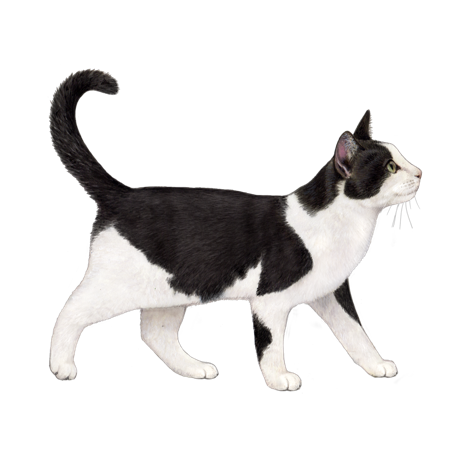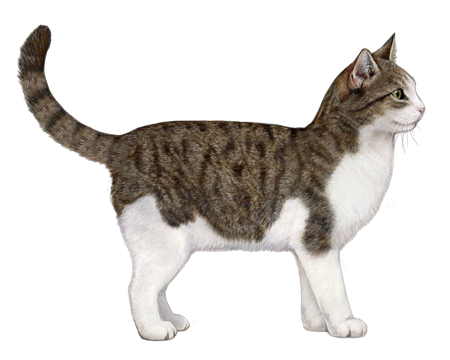
Russian Blue
Gentle and intelligent, Russian Blues can be shy. But once humans earn their trust, they'll be waiting at the door to greet them with their trademark smile. These cats are also known for their longevity—with some Russian Blue living to the ripe old age of 25.
Interested in discovering if your cat is a Russian Blue?
Check out Wisdom Panel's DNA test.
Russian Blue Traits
General Appearance
Russian Blues are medium-sized cats with lithe and muscular bodies. They're best known for their silvery-blue coats, emerald eyes, and smiling faces.
Coat and Colouring
The Russian Blue's plush double coat is short and dense, with a soft, silky texture. The breed's hair is bright blue and has silver tips that give it a shimmery appearance.
Distinctive Physical Traits
Russian Blues have a wedge-shaped head and blunt muzzle. Their large, flared ears are wide at the base and serve as a frame for their face. The breed's wide-set, round eyes come in a gorgeous, vivid green color. And a long body, fine-boned legs, and dainty paws give these cats a graceful, elegant appearance.
Russian Blue Temperament
Russian Blues have a regal air about them. They can be shy around strangers and may take a "wait and see" approach to new situations (often waiting behind a couch or high on a perch). But they're devoted to the humans they deem worthy of their trust.
Because of their tentative nature, Russian Blues prefer a quiet household. And though they get along great with other pets and kids, they don't need constant companionship. They're perfectly capable of keeping themselves entertained while the family is away at work or school.
Fetch is a favorite activity for these playful cats. They'll frequently present toys to their humans to initiate a game and don't expect the session to end until they've had their fill. But when it's time to relax, they happily curl up in their favorite human's lap.
Russian Blues also appear to be tuned into people's moods. And if they sense someone in their family is feeling down, they'll do their best to lift their spirits.
Russian Blue History
The origin of the Russian Blue is uncertain. But many people believe these smart cats came from the Russian port of Arkhangelsk (or Archangel), just south of the Arctic Circle. The weather conditions in that region would certainly explain the breed's thick, plush coat. The cats then likely hopped aboard ships and traveled with sailors to other parts of Europe.
The Russian Blue's history comes into focus in 1875—when the breed appeared at London's first cat show at the Crystal Palace. Known then as the "Archangel Cat," they competed with all other blue cats. Afterward, breeders worked to develop the breed. And in 1912, Russian Blues were assigned a separate class for competition.
World War II dealt a blow to the Russian Blue's breeding program (as it did for most breeds), and the number of cats dwindled. After the war, breeders crossed their remaining stock with blue British Shorthair or blue point Siamese to revive their breeding lines. Around this time, breeders in North America took an active interest in advancing the Russian Blue's development. So, they imported cats from Scandinavia and England and worked to develop the features of the breed we know today.
Russian Blue Care
Nutrition
Russian Blues require a high-quality diet. Because nutritional needs vary for kittens, adults, and senior cats, opt for a formula that's age-appropriate for your pet.
To help your cat stay at a healthy weight, monitor their food amount and reduce portions if necessary. And don't forget to account for snacks in their overall calories. As a guideline, treats should make up no more than 10% of a cat's daily intake.
Finally, keep in mind that all cats need easy access to fresh, clean water at all times.
Grooming
Despite their plush coats, Russian Blues aren't heavy shedders. So, weekly brushing is usually enough to keep their coats looking and feeling great.
Monthly nail trims can help keep your cat's nails from growing too long, snagging on something, and becoming torn or damaged. (Plus, overgrown nails can grow into their paw pads, leading to pain or infection.) And providing a scratching post will allow your cat to do a little nail maintenance themselves—and satisfy their instinct to scratch.
No cat care routine is complete without dental care. From a young age, start your Russian Blue on a dental routine that includes at-home teeth brushing and professional exams and cleanings.
Health
Roughly one out of every three cats in the United States is overweight or obese. And those extra pounds can contribute to other health risks—such as arthritis, diabetes, and heart problems. Your veterinarian is the best resource for tips on managing your cat's weight.
Breed Group
Western
The largest of breed groups, the Western Group is mainly comprised of cats developed in Europe and the Americas. Due to the complexity of feline genetic diversity, however, cat breeds from other regions may also be found associated with this group.
Resources
https://tica.org/breeds/browse-all-breeds?view=article&id=869:russian-blue-breed&catid=79
https://cfa.org/wp-content/uploads/2019/06/russian-blue-standard.pdf
https://www.royalcanin.com/us/cats/breeds/breed-library/russian
https://vcahospitals.com/know-your-pet/cat-breeds/russian-blue
https://www.banfield.com/state-of-pet-health/obesity
Reviewed 23 February 2021 by Annette Louviere, DVM




































